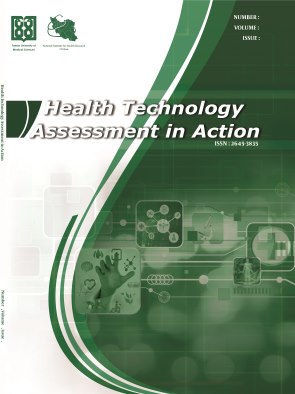Incidence of Febrile Neutropenia in Neutropenic Cancer Patients Admitted to Oncology Ward of Shahid Ghazi Tabatabai Hospital in Tabriz During 2018-2020
Abstract
Background: Chemotherapy-induced neutropenia is one of the risk factors for infection in patients undergoing chemotherapy (due to the weakened immune system). Febrile neutropenia (FN) may be the sole indicator of an underlying infection in these patients.
Objectives: Since infection is associated with an increased risk of mortality in patients undergoing chemotherapy, the present study aimed to assess the incidence of FN in neutropenic cancer patients admitted to an oncology ward.
Methods: This retrospective, descriptive, and cross-sectional study was conducted on 52 patients (selected using the census method) with signs of infection (i.e., FN) hospitalized in Ghazi Tabatabai Hospital in Tabriz, Iran, within 2018 - 2020. The data were collected by a researchermade form and analyzed using descriptive statistics (e.g., frequency, percentage, and mean) and chi-square in SPSS software (version 20). The significance level was considered less than 0.05.
Results: The absolute neutrophil count was less than 500 cells/ml in 15.38% of the patients (n = 8). Infection was the cause of FN in 69.23% of the subjects (n = 36). An unknown factor was the cause of infection in 30.77% of the cases. The incidence of all types of infections (i.e., perianal abscess, sepsis, oral infection, cutaneous infection, gastrointestinal infection, pharyngitis, pneumonia, and urinary tract infection) was higher in patients undergoing chemotherapy than that reported for those not receiving chemotherapy.
Conclusions:The results of this study suggested that cancer patients undergoing chemotherapy should be aware of infection signs; accordingly, they can visit treatment centers in case of the first symptoms of infection to prevent progression of infection and reduce mortality rates.
2. Aghamohammadi D, Mehdinavaz Aghdam A, Khanbabayi Gol M. Prevalence of Infections Associated with Port and Predisposing Factors in Women with Common Cancers Under Chemotherapy Referred to Hospitals in Tabriz in 2015. The Iranian Journal of Obstetrics, Gynecology and Infertility. 2019;21(11):7-13.
3. Fontanella C, Bolzonello S, Lederer B, Aprile G. Management of breast cancer patients with chemotherapy-induced neutropenia or febrile neutropenia. Breast care. 2014;9(4):239-45.
4. Cameron D. Management of chemotherapy-associated febrile neutropenia. British journal of cancer. 2009;101(1):S18-S22.
5. Cho B-J, Kim KM, Bilegsaikhan S-E, Suh YJ. Machine learning improves the prediction of febrile neutropenia in Korean inpatients undergoing chemotherapy for breast cancer. Scientific reports. 2020;10(1):1-8.
6. Chan A, Chen C, Chiang J, Tan SH, Ng R. Incidence of febrile neutropenia among early-stage breast cancer patients receiving anthracycline-based chemotherapy. Supportive care in cancer. 2012;20(7):1525-32.
7. Lyman GH, Abella E, Pettengell R. Risk factors for febrile neutropenia among patients with cancer receiving chemotherapy: a systematic review. Critical reviews in oncology/hematology. 2014;90(3):190-9.
8. Lyman GH, Michels SL, Reynolds MW, Barron R, Tomic KS, Yu J. Risk of mortality in patients with cancer who experience febrile neutropenia. Cancer. 2010;116(23):5555-63.
9. Whyte S, Cooper KL, Stevenson MD, Madan J, Akehurst R. Cost-effectiveness of granulocyte colony–stimulating factor prophylaxis for febrile neutropenia in breast cancer in the united kingdom. Value in Health. 2011;14(4):465-74.
10. Lyman GH, Kuderer NM. Epidemiology of febrile neutropenia. Supportive cancer therapy. 2003;1(1):23-35.
11. Engert A, del Giglio A, Bias P, Lubenau H, Gatzemeier U, Heigener D. Incidence of febrile neutropenia and myelotoxicity of chemotherapy: a meta-analysis of biosimilar G-CSF studies in breast cancer, lung cancer, and non-Hodgkin’s lymphoma. Oncology Research and Treatment. 2009;32(10):599-604.
12. Hatamabadi H, Dolatabadi AA, Akhavan A, Safari S. Clinical Characteristics and Associated Factors of Mortality in Febrile Neutropenia Patients; a Cross Sectional Study. Archives of academic emergency medicine. 2019;7(1).
13. Nomura M, Morita Y, Kakiuchi A, Ishida K, Iizuka M, Yagi Y, et al. The association between chemotherapy-induced febrile neutropenia and breast cancer subtype in Japanese patients. International journal of clinical pharmacy. 2020;42(1):7-10.
14. Michels SL, Barron RL, Reynolds MW, Tomic KS, Yu J, Lyman GH. Costs associated with febrile neutropenia in the US. Pharmacoeconomics. 2012;30(9):809-23.
15. Ahmadinejad Z. Fever and neutropenia due to cytomegalovirus infection in a breast cancer patient under chemotherapy: a case report. Tehran University Medical Journal. 2010;68(3).
16. Farzanfar F, Parvaresh S, Farahmandinia Z, Sarafinejad A, Gharaei N. The Diagnostic value of IL8 compared with CRP, ESR in the detection of bacterial infections in pediatric oncology patients with febrile neutropenia. scientific journal of ilam university of medical sciences. 2017;25(3):160-8.
17. Keyhanian S, Alipoor ZJ, Moghaddam HZ, Fotoukian Z, Nava MO, Saravi M. A study of fever causes in neutropenic patients hospitalized in oncology ward of Imam-Sajjad Hospital in Ramsar. Scientific Journal of Iranian Blood Transfusion Organization. 2014;11(3).
| Files | ||
| Issue | Vol 4, No 4 (2020) | |
| Section | Articles | |
| DOI | https://doi.org/10.18502/htaa.v4i4.6869 | |
| Keywords | ||
| Fever Chemotherapy Cancer Neutropenia Infection | ||
| Rights and permissions | |

|
This work is licensed under a Creative Commons Attribution-NonCommercial 4.0 International License. |




